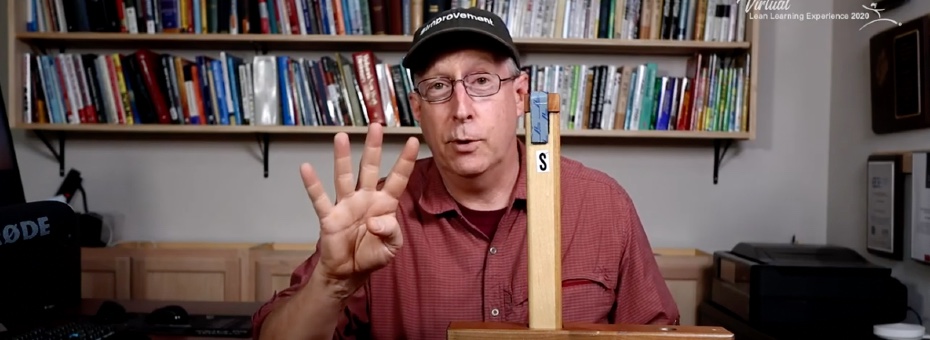Part five of eight. Watch the others:
- Part one, A Focus on Muda
- Part two, Overproduction
- Part three, Excess Inventory
- Part four, Excess Conveyance
- Part six, Waiting
- Part seven, Defects
- Part eight, Processing
Hi, everyone. This is Art Smalley, president of Art of Lean, Incorporated. Today, on behalf of the Lean Enterprise Institute, we’re going to do a series of short video clips, each one about the seven classic forms of waste from the Toyota Production System. Stick around. I think you’ll enjoy them.
Waste No. 4 – at least for me, this is number four. You can debate it’s five, six, seven, or whatever number for you. It’s motion, the waste of motion. It’s a logical one for me to put here, although it doesn’t follow from one to two to three, as naturally as the first three did.
Inevitably, this is centered around some form of motion, whether it’s transportation motion, human motion, or machine motion. You have to have the ability to spot waste in your job that’s due to the motions that you perform. Okay? This can be on a keyboard. Doesn’t matter. It can be done in your motions on a machine or doing some type of changeover work, or it could be the physical assembly type of motions you do.
Now, let’s come back to our machine for a second. I will, again, operate it from the rear, sitting down to allow for a good viewing angle. If you watched the previous videos and saw some of the motion involved with it, you might’ve noticed I did it a couple of different ways intentionally. And that’s because the more detailed you look, you’re going to find wasted motion and people doing things slightly differently. At some level, it doesn’t matter when you get down to microseconds and micro motions; nobody ever does it exactly the same way. I mean, the path your hand is going to trace is not exactly the same every time, but in a macro sense, you want jobs to be as standardized and efficient as possible.
You want to look at any sequence of events and look at the motion involved. At the detail level, there are always minor inconsistencies… that’s a hint at some inefficiency…
So I put my raw material in over here, cycle the machine, the nut comes out and here – see, I had to fumble to get it; that was a wasted motion – and I put it on the pallet. The second one here, this time, I put the ball in, cycle it, and let’s say this time it came out neater. I didn’t have as much fiddling motion. I still found it in, but in two different ways, even though I’m performing the same action.
Now, what happens if I do this? I put the ball in, cycle it, run it. Oh, nothing happened. There was a jam. There was a wasted motion there. I put it in again – oh, it came out this time, fell off to the side a little bit. I put the ball in, took it out, ran another one, took it out, ran another one, and it came out fine. But even in that sequence, there’s some waste because I didn’t pick it up on the last three.
They went to different areas. There’s one here. There’s one that came off over there, and here’s one over there. At the macro levels, I cycled the machine the same way, but at the micro levels, I didn’t make the exact same motions every time. And you honestly can’t, if we’re talking about the atomic level of precision and microseconds, but at a macro level, you want to get into standardized routines and say, what’s best. Obviously, for this machine, I think it needs some kind of chute that gently has the part come out and puts it in a fixed stop location. That would be a requirement typically on a Toyota machine. I don’t have it on this one, but if it had that fixed stop location, you could then pick it up and move it every time. On advanced machines, ideally the part would exit on its own and set itself into the designated location.
Or today, they have robotics and more advanced things, and as the machine cycles, both for input and for output, the part is put in automatically. The part is picked up automatically and put into a specified location, okay? And machines are more repetitive than humans, but of course, they also break down. They don’t have the intellectual capabilities that we do as problem-solvers. But the idea is still the same. You want to look at any sequence of events and look at the motion involved. At the detail level, there are always minor inconsistencies. When you see it, that’s a hint at some inefficiency or a little trouble spot in the equation. It could be the way we have to fiddle with things, the way the part comes out, the way we put it in boxes, and the way we reach for things. It turns out there’s a lot to motion.
I’ll cover this in a follow-up video that, in conjunction with the concept of motion, Toyota actually historically taught the 17 third legs. So you can break motion down into 17 symbols. If you learn those 17, only like three of them were value-add, and 14 were waste. If you learn to memorize all 17 of those motions and understand them, no matter what you look at, you see, well, the world is full of waste and the motions we make – whether it’s machine or human – and all those represent opportunities to kind of shrink down the waste. Once you learn to understand it better, minimize it, and get an easier, safer, more repetitive sequence of actions.
But it starts with observation—the ability to see motion at the detailed level, spot all the differences, discern the bigger from the smaller – and say, we want to target those for improvement. That’s the fourth waste, motion.






